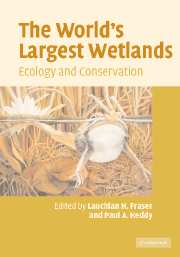Book contents
- Frontmatter
- Contents
- List of contributors
- Preface
- 1 Introduction: big is beautiful
- 2 The West Siberian Lowland
- 3 The Amazon River basin
- 4 The Hudson Bay Lowland
- 5 The Congo River basin
- 6 The Mackenzie River basin
- 7 The Pantanal
- 8 The Mississippi River alluvial plain
- 9 The Lake Chad basin
- 10 The River Nile basin
- 11 The prairie potholes of North America
- 12 The Magellanic moorland
- 13 The future of large wetlands: a global perspective
- Index
- References
12 - The Magellanic moorland
Published online by Cambridge University Press: 10 August 2009
- Frontmatter
- Contents
- List of contributors
- Preface
- 1 Introduction: big is beautiful
- 2 The West Siberian Lowland
- 3 The Amazon River basin
- 4 The Hudson Bay Lowland
- 5 The Congo River basin
- 6 The Mackenzie River basin
- 7 The Pantanal
- 8 The Mississippi River alluvial plain
- 9 The Lake Chad basin
- 10 The River Nile basin
- 11 The prairie potholes of North America
- 12 The Magellanic moorland
- 13 The future of large wetlands: a global perspective
- Index
- References
Summary
Introduction
Globally, wetlands cover an estimated 7 to 8 million km2 (Mitsch et al. 1994). These azonal ecosystems are widely and disjunctively spread throughout all major biomes of the Earth, following no evident pattern. Under the guise of wetlands fall a wide variety of ecosystems, ranging from open water bodies to peatlands. A comprehensive global strategy for the conservation of wetlands, thus requires recognition of the huge diversity of wetlands, and intimate knowledge of local environmental conditions and the biota of each wetland area and surrounding vegetation types. Because major wetland areas occur at many latitudes and are embedded in many different terrestrial ecosystems, it stands to reason that the sum total of wetland biodiversity could turn out to be quite high on a global scale in comparison with land area occupied by wetlands.
The southwestern border of southern South America is characterized by cool and windy summers, with recorded annual average precipitation reaching as high as 7 m on one offshore island. This area (and others further to the north) was heavily glaciated in the Pleistocene, and today consists of a highly dissected, rugged landscape interrupted by two major icefields (Southern Patagonian and North Patagonian) and numerous fjords. Corresponding closely in its distribution to this heavily glaciated land area is found a major area of cool temperate wetlands (Fig. 12.1).
- Type
- Chapter
- Information
- The World's Largest WetlandsEcology and Conservation, pp. 424 - 445Publisher: Cambridge University PressPrint publication year: 2005
References
- 3
- Cited by



